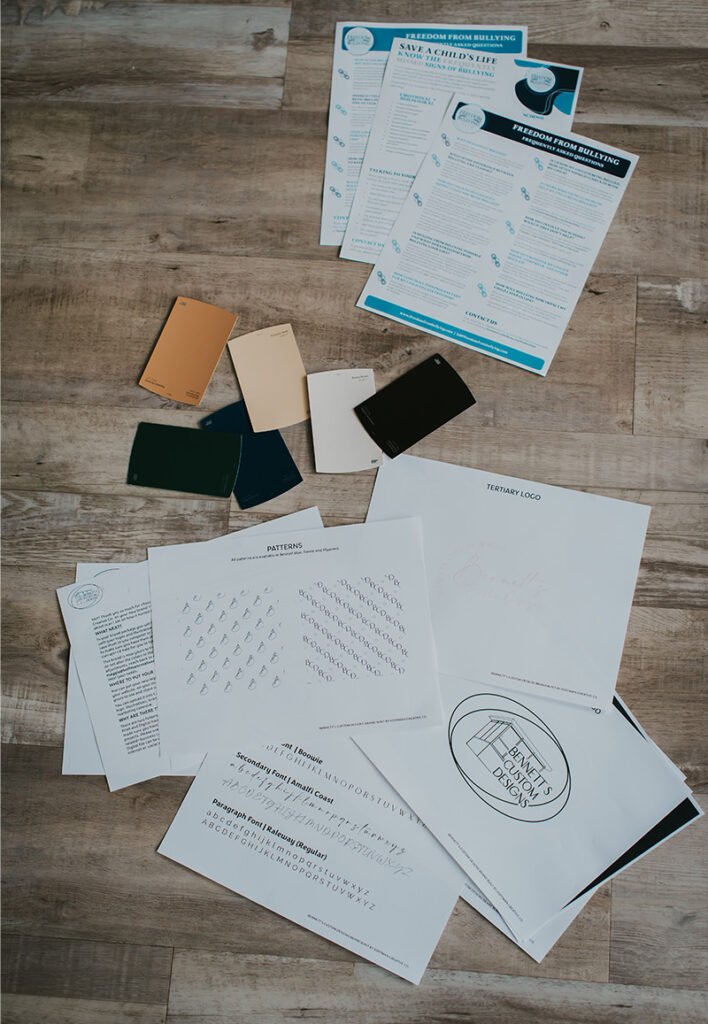Categories
i'm Maggie
Your average Canadian, who loves hot tea, hates socks and helping your business have a show-stopping brand and website
Branding
Design
Websites
About Maggie
What You Need To Get Started Before You Book a Designer
So you *think* you’re ready to get a rebrand. But then you have a little nagging voice in the back of your mind stopping you from reaching out to your favourite designer, saying “what do I actually need before I get a rebrand?” And “Am I at a place in my business to rebrand?”
Well I’m here to help remove those fears by sharing some questions to ask yourself as you prepare for a rebrand, AND what else you can prep before you sign on your designer.

What to Ask Before a Rebrand
I want you to really focus on the principles of “know, like, and trust.” Consumers buy from someone that fits those three categories.
So when thinking about a possible rebrand, as yourself these questions with a lense of “know, like, and trust.” As well, be sure to think about your brand from your ideal client’s perspective.
1. How do you want people to feel when they interact with your brand? Are they doing that?
Think about your brand voice, attributes, and tone. This one is an important question to review because your ideal client may look at your business and see an area that turns them away or doesn’t connect with them. Thinking through what you want your ideal client to think, feel, and act with your brand is key.
If your brand voice is causal, but all your website copy and marketing materials have a professional tone, there is a disconnect, and likely you’re confusing your clients.
One way to evaluate this is to ASK! Ask your ideal clients what their perceptions are of you, and does your branding live up to that?
2. Are you having any problems with your current brand?
Do people not understand who you are? Are you booking clients that don’t fall into your ideal market? Think through this. You could be attracting the wrong type of people because your branding isn’t polished and tailored to the right market.
3. Are you booking clients?
While this might not be an overall test of your brand, it is something to consider. If your current DIY brand is not helping you book clients, then you will likely need to reassess. Similarly, people book those they know, like, and trust. And a good brand will help build your reputation (trust). If people are unsure whether to trust you, then you likely won’t be booking any new projects.
4. Are you adding any new offerings that might not fit within the old brand?
This one is thinking about longevity. If you’re planning on adding a new offering, will your brand live up to that service? Or will it look and feel off? Thinking of where you want your business to grow to is helpful in assessing if your brand will be evergreen or need a facelift.
Another item similar to this is if you are pivoting your business entirely. If so, then it’s time for a rebrand.
If You Know It’s Time for a Rebrand
Alright, so you have gone through the questions above and come to the conclusion that you in fact do need a rebrand. Congratulations!
I know it can be intimidating, but the hope is when you find the right designer for you, your project will go SO smoothly. And it doesn’t hurt to have some homework done BEFORE you even talk with a designer.
Getting Ready Checklist for Rebrand
Now the process of every designer will be different, and likely some of these items may differ slightly. But if you gather these things before you sign on your designer, trust me, you will be saving them (and you) some work later.
These are items that I have my clients gather once we onboard for a new project.
1. Brand Images & Website Images (And Videos)
This is pretty self-explanatory, but getting images takes TIME! If you haven’t scheduled a brand shoot, then I’d say get that on the calendar, so that when you book a designer, you can have new images before your launch.
Also gathering images, whether stock or ones you’ve taken is important, and can save your designer from scouring the internet. The same thing with video content, which takes time to edit, so make sure you have booked those in advance.
2. Website Copy
Writing takes time. And website copy is different than other writing. So give yourself LOTS of time to start writing your copy. This is also helpful as your designer likely won’t be able to design your website without the copy.
So *please* get a headstart on that before you book.
3. Legal Pages: Privacy Policy + Terms & Conditions
If you are getting a new website—even if you have an existing site—you NEED to have a privacy policy. If your old site has one, then no worries, get a copy of that and update as needed.
But if you don’t have the necessary legal pages, go ahead and start looking for those. I recommend contracts from thelegalpaige.com. She has a website bundle that has all the contracts you need for your business website.
4. Contact Forms, Pop-ups, Embed Codes
If you’re using a CRM (HoneyBook or Dubsado) go ahead and get your contact form ready. You can build those out simply and then pass along the embed code so your designer can easily pop that in.
Same with any pop-ups. If you have an email marketing system opt-in, go ahead and create that ahead of time so you are prepared.

5. Testimonials & Portfolio Work
If you’re just starting out (congrats!) you may not have many testimonials. Which is alright, those can always be added in later. But if your business has been around for a while then I’d recommend gathering all your testimonials and putting them in one spot.
This not only helps you—if you want to share them on social media—but you can easily pass them along to your designer for them to use.
take some time every few months to put all those kind words in a folder. *I also go back and reread mine on hard days. It’s a nice pick-me-up.
I also recommend getting all the pieces you need in order for any portfolio work that you want to share. Don’t forget those before and afters!
6. Write Blog Posts
Similar to writing your copy, if you’re getting a blog built I recommend writing your blog posts. Now you don’t need to write a ton. I recommend launching a website with three posts at a minimum.
So take some time and think about what important information your clients may need and write up a blog post. This also reduces the things you need to write while you are knee-deep in the design work and possibly your busy season.
7. Gather Shop Items
If you have (or plan to have) an e-commerce site, I recommend gathering all the shop information before signing your designer on. Things like item name, description, cost, and getting images, can really help you feel prepared when you sign on the designer.
This also is helpful for you so you know if you need to get anything else done while the shop is being built.
8. Membership Details & Affiliate Links
Last, but not least, your membership details. This is more applicable if you will be having a membership side to your business but also think about affiliate links. Getting all the information organized ahead of time helps reduce your stress and also helps you stay on top of your business.
Got My List Done, Now What?
If you’ve gone through the checklist above, now it’s time to go find the designer! The items in this blog post are meant to help you stay organized, and also give your designer some peace of mind as they begin your project.
NOTE: Most designers are booking months in advance. So while you’re looking, and even if you’ve booked them, you should have some time to revisit this list and complete it before your project beings.
I hope this post is helpful, and if you are ready for a redesign, pop into my calendar and we can chat more about what you’re looking for!